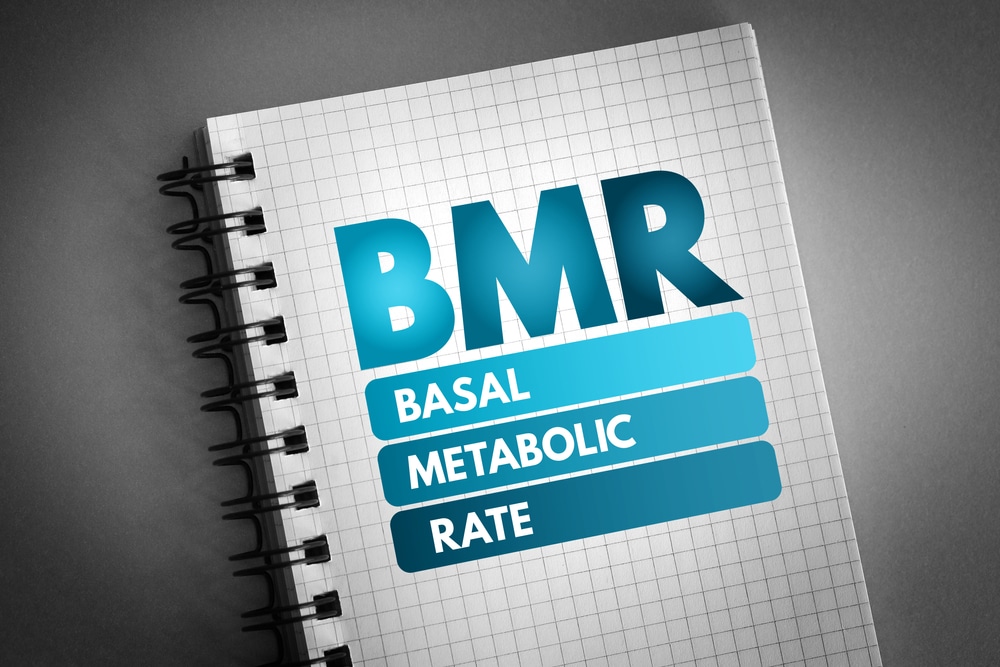In the human body, every cell needs the energy to function. Specific cells come together and form tissues; tissues together create organs, bones, muscles, and joints. These cells that form particular tissues help us breathe, circulate blood, reproduce or repair cells, and process nutrients. The cells that go through these processes need energy even when they are resting. Your body burns energy as you live; this amount of energy is called the Basal Metabolic Rate (BMR).BMR is an actual caloric number that your body needs to sustain life functions. You can calculate your estimated BMR with many formulas, such as the Harris-Benedict Formula. The Harris-Benedict Formula depends on weight, height, age, and gender, all factors that strongly determine your BMR. Try it on yourself to figure out how much energy you’ll need throughout the day.The formula looks like:
- For females: BMR = 655 + (9.56 × weight in kg) + (1.85 × height in cm) – (4.68 × age in years)
- For males: BMR = 66.5 + (13.76 × weight in kg) + (5 × height in cm) – (6.76 × age in years)
You’ll also need to add a few more variables to your calculations to determine your ideal daily caloric intake. The following variable to add to this equation is the activity factor.Classify yourself as:
- Sedentary (minimal to no exercise at all), multiply your BMR by 1.2.
- Lightly active (1-3 days/week exercise), multiply your BMR by 1.375.
- Moderately active (3-5 days/week exercise), multiply your BMR by 1.55.
- Very active (6-7 days/week exercise), multiply your BMR by 1.725.
- Extra active (intense exercise or physically heavy job for 6-7 days/week), multiply your BMR by 1.9.
Boom! Now you have the activity factor, add it to your BMR and let’s move on to the final variable.Thermic Effect of Food (TEF), also called dietary-induced thermogenesis, refers to the increase in metabolism after a meal and accounts for approximately 10% of your total energy use. It represents the energy use of processing and storing food and the metabolic effects of the influx of nutrients. Your BMR will compose roughly 70% of your caloric needs, physical activity will be 20%, and TEF 10% of total energy expenditure. Since you have calculated your BMR with the Harris-Benedict Formula and added the activity factor. It only leaves us to add 10% more to estimate the total calories you need. Calculate 10% of the sum of your BMR multiplied by the activity factor and add it to your equation.
It’s all about weight goals
Considering you are following a healthy diet, you now know how many calories you need daily. Since you know how many calories you burn in a day, you’ll learn how much to eat. So if your goal is:
- Weight gain, consume more calories than you burn.
- Weight loss, consume fewer calories than you burn.
- Weight maintenance, consume the same number of calories that you burn.
Let’s take weight loss as a goal. You can start by simply decreasing your daily calorie intake by 10-15% to start losing weight. If you want to take a ruthless approach, a 30% decrease will help you lose weight faster. The weight gain process can be done following the exact percentages. Still, the only difference will be increasing consumption instead of decreasing. So consume roughly 10% more calories than your BMR for slower and 30% more for faster weight gain while you’re staying healthy.
Stay healthy, don’t forget about the macros
Now it’s the last part of the diet, nutritional tracking. As long as you want to stay healthy, you should stick with healthy food options and essential healthy distributions of macronutrients or macros.Protein, carbohydrates, and fats are the macros. We need a basic amount of all of those for a healthy physiological function. As long as you don’t take out one of them entirely from your diet and stay within the healthy ranges of protein and fats, you can modify the percentages of your diet. Stick to a plan that is sustainable, healthy, and the one that you like. Whether it’s weight loss, maintenance, or gain, your goal won’t be a pipe dream!



Recent Comments